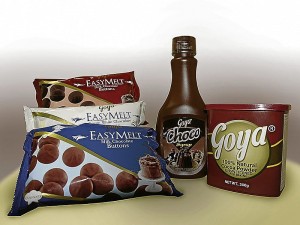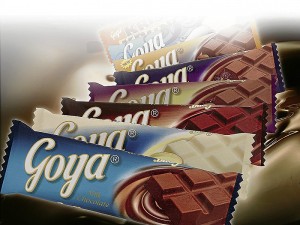What’s new with 54-year-old Goya
MANY FILIPINOS will consider tasting Goya chocolates as one of their fondest childhood memories. For some, their earliest memories of Goya are the cube-sized chocolates wrapped in foil. But now, Goya has gone through a total makeover while keeping its familiar and nostalgic taste.
But for Jose Nilo Chincuanco Jr., director and general manager of Delfi marketing Inc., owner of Goya, the rebranding of the old chocolate favorite was not that sweet. According to him, until now they are facing rough waters yet slowly but surely going forward. He is definitely sure that Goya will continue to make life sweeter for every Filipino.
Beginning
It was in 1956, when the journey of the heritage brand began. The families of Chua and Villabrille started to manufacture coffee and chocolates under the name of Philippine Cocoa. Throughout the years, this company has been placed under the stewardship of different owners. In 1997, Philippine Cocoa was acquired by Nestle.
Petra Foods—a publicly listed company in Singapore—came into the picture in 2006 and they eventually bought Philippine Cocoa from Nestle.
Petra Foods is among the top three suppliers of cocoa in the world and it has Delfi Corp. as its consumer marketing group.
Steps of recovery

KNOWN for serving up mouth-watering delights, Goya has diversified into baking, manufacturing products such as easy melts. It also has choco syrups and cocoa drinks. CONTRIBUTED PHOTO
Under the wings of Delfi Corp., Goya took the first steps of its journey to recovery. “We looked at the existing product range and decided to introduce a variety of chocolates to the market,” Nilo says.
But for him, the road to recovery was like “climbing Mount Everest.” There were so many roadblocks along the way. Among them is the reorganization and revitalization of the manpower of Goya.
“We had to look at the capabilities of the people, check their competency level and to change their mind-set as well,” he adds.
He says that it was not an easy task to seamlessly make the management collaborate with the manpower of the company. However, management decided to keep everybody involved in the restructuring of the brand. “We wanted them to realize the real potential of the brand and how it can still compete effectively in the market,” he says.
Though the challenges were great and seemingly odd, Chincuanco says that they would rather not focus on the issues but on the challenges they have to meet in order to do what needs to be accomplished.
After checking each individual’s competencies and strengths, the group implemented tailor-made positions to determine who will be the best to lead a certain team. “We put the person whom we think would be the best person for the job,” he adds.
Tackling the manpower
On a management basis, Delfi Corp. handled the manpower reorganizations one step a time. The first step was showing the people where they stand as a company, where the brand is in the market and helping them visualize where they are heading into the future.
“We wanted our employees to be empowered and so we recognized their capabilities and capitalized on them,” Nilo adds.
After infusing in the minds of their employees the values of hard work, discipline and team effort, they now focused on a different challenge and that is the makeover of Goya chocolates.
“Innovation is key,” Nilo says. Before there were only three to four Goya brands available in the market. But since they are keen on facing the challenges head on, they decided to excite the market by increasing the then four brands into 10.
In addition, they also modified the packaging into a vibrant one. “It was the first step to turn the brand into something attractive and competitive once again,” Nilo adds.
They became more aggressive with advertising and promotions. Also, they invested in TV commercials to send a message to the world and that is to “Enjoy life, Enjoy Goya.”
Brand positioning
Another challenge was where to position Goya chocolates in the market. “We decided that we can become key players in the medium-end and lower-end brackets,” he says. Thus, Goya chocolates became a premium chocolate brand that is affordable.
“It was our vision that every Juan dela Cruz deserves to have a chocolate that is not so heavy in the pocket yet it also offers the same sensation,” Nilo adds.
True enough, they were able to tickle the taste buds of the Filipinos by offering a variety of sweet treats. From the plain cube-sized chocolates, they now have dark chocolates, dark mint chocolates, white chocolates, almonds dipped in chocolates, crunchy bite-size chocolates and even choco-covered biscuits.
The brand also ventured in chocolate spreads and even to baking ingredients such as chocolate buttons, easy melts, chocolate syrup and baking powder.
“Anything that has to do with chocolates, Goya has one,” the 44-year-old director says.
Confectionery consumer
Goya has taken advantage of the fact that the Philippines is the second confectionery consumer in Asia while Indonesia takes the top spot.
Not only do they want their consumers to enjoy every bite of a Goya chocolate but they also wanted them to get their money’s worth. And they sell a million chocolate bars every month.
All chocolates are made and manufactured in a three-hectare plant in Marikina City that has been certified with IS0 2200 in 2009. “Quality is most important to us,” says Nilo.
Since 2006, Goya has grown 50 percent in its sales. But for the company, “It’s just 50 percent if you translate it to sales then just 50 cents so we have to continue to innovate and keep on introducing new products,” Nilo adds.
According to AC Nielsen, Goya used to have no market share at all. But now, it is currently enjoying a 6-percent market share.
But some still criticize the rebirth of Goya chocolates. Some say that they are just copying the format and looks of other established chocolates in the industry.
Yet for Nilo, “We just meet the competition head on and we believe in competition. It gives the people the right to choose. And at the end of the day, competition leads to growth.”
He always attributes the growth and success of the Goya chocolates to the people who work in the background. “We always believed that as long as the fundamentals are in place then the sales and profits would just come in. And up to now, we’re still asking the question ‘What’s next for Goya?’” he says.
And there seems to be no stopping the sugar high that Goya is experiencing, the company is also planning on adding more exciting products in its lineup for the coming months.
“We are striving to become better every day. We believe in our brand and Goya being a heritage brand is a brand that should continue to live on in the Philippines,” Nilo says.


